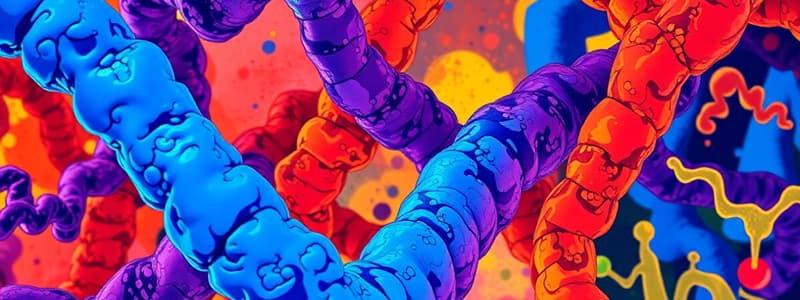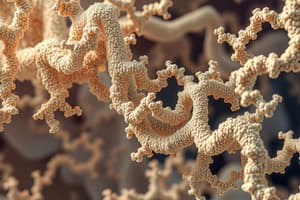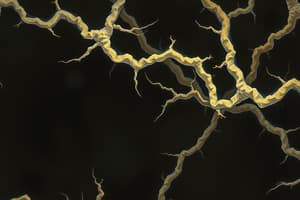Podcast
Questions and Answers
What distinguishes fibrous proteins from globular proteins?
What distinguishes fibrous proteins from globular proteins?
- Fibrous proteins have a long and narrow shape. (correct)
- Fibrous proteins have an irregular amino acid sequence.
- Fibrous proteins are generally soluble in water.
- Fibrous proteins are primarily functional in roles.
Which of the following statements accurately describes the role of collagen in the human body?
Which of the following statements accurately describes the role of collagen in the human body?
- Collagen regulates metabolic processes within cells.
- Collagen is the primary protein found in muscle fibers.
- Collagen provides structural support in connective tissues. (correct)
- Collagen is primarily involved in enzyme catalysis.
What is a characteristic feature of the amino acid sequence in fibrous proteins?
What is a characteristic feature of the amino acid sequence in fibrous proteins?
- Repetitive in nature. (correct)
- Consistently hydrophilic residues.
- Highly variable with frequent substitutions.
- Irregular and unpredictable.
Which disease is primarily associated with abnormalities in collagen and elastin?
Which disease is primarily associated with abnormalities in collagen and elastin?
Which structural feature is associated with collagen and elastin?
Which structural feature is associated with collagen and elastin?
How do fibrous proteins generally respond to changes in pH or temperature compared to globular proteins?
How do fibrous proteins generally respond to changes in pH or temperature compared to globular proteins?
In which tissues are collagen and elastin predominantly found?
In which tissues are collagen and elastin predominantly found?
Which of the following best describes the solubility of fibrous proteins?
Which of the following best describes the solubility of fibrous proteins?
What is one of the primary functions of elastin in the human body?
What is one of the primary functions of elastin in the human body?
What is the primary role of hydroxyproline in collagen?
What is the primary role of hydroxyproline in collagen?
Which enzyme requires vitamin C for its hydroxylation reactions?
Which enzyme requires vitamin C for its hydroxylation reactions?
What is a major consequence of vitamin C deficiency on collagen synthesis?
What is a major consequence of vitamin C deficiency on collagen synthesis?
Which condition is characterized by defects in collagen synthesis due to mutations in the amino acid sequence?
Which condition is characterized by defects in collagen synthesis due to mutations in the amino acid sequence?
What is a distinguishing feature of Type II Osteogenesis Imperfecta?
What is a distinguishing feature of Type II Osteogenesis Imperfecta?
What role does elastin play in connective tissue?
What role does elastin play in connective tissue?
What is a clinical manifestation of collagen fiber disorder Ehlers-Danlos Syndrome?
What is a clinical manifestation of collagen fiber disorder Ehlers-Danlos Syndrome?
Which of the following conditions is referred to as brittle bone syndrome?
Which of the following conditions is referred to as brittle bone syndrome?
Which amino acid is critical for the hydroxylation process that stabilizes collagen?
Which amino acid is critical for the hydroxylation process that stabilizes collagen?
What is the role of lysyl hydroxylase in collagen synthesis?
What is the role of lysyl hydroxylase in collagen synthesis?
What is the significance of proline in the collagen molecule?
What is the significance of proline in the collagen molecule?
Which type of collagen is primarily found in skin and bone?
Which type of collagen is primarily found in skin and bone?
What role does glycine play in the structure of collagen?
What role does glycine play in the structure of collagen?
Which type of collagen forms a network in the basement membrane?
Which type of collagen forms a network in the basement membrane?
What is the general structural characteristic of the collagen triple helix?
What is the general structural characteristic of the collagen triple helix?
Which amino acids are specifically noted for their presence in collagen?
Which amino acids are specifically noted for their presence in collagen?
Type III collagen is primarily associated with which tissue types?
Type III collagen is primarily associated with which tissue types?
What is the function of hydroxyproline in collagen?
What is the function of hydroxyproline in collagen?
Which type of collagen is known for linking fibrils to one another and to other extracellular matrix components?
Which type of collagen is known for linking fibrils to one another and to other extracellular matrix components?
The collagen molecule's α-chains are primarily characterized by which of the following?
The collagen molecule's α-chains are primarily characterized by which of the following?
Flashcards
Fibrous Proteins
Fibrous Proteins
Proteins with elongated shapes, forming rod-like structures, usually involved in structure or storage.
Globular Proteins
Globular Proteins
Proteins with a round or spherical shape, often involved in functional roles, like enzymes.
Collagen
Collagen
The most abundant protein in the human body, important for structural support in tissues.
Elastin
Elastin
Signup and view all the flashcards
Collagen Function
Collagen Function
Signup and view all the flashcards
Elastin Function
Elastin Function
Signup and view all the flashcards
Fibrous vs. Globular
Fibrous vs. Globular
Signup and view all the flashcards
Fibrous Protein Examples
Fibrous Protein Examples
Signup and view all the flashcards
Collagen Abundance
Collagen Abundance
Signup and view all the flashcards
Collagen Locations
Collagen Locations
Signup and view all the flashcards
Collagen Molecule Structure
Collagen Molecule Structure
Signup and view all the flashcards
Collagen Type I
Collagen Type I
Signup and view all the flashcards
Collagen Type II
Collagen Type II
Signup and view all the flashcards
Collagen Type III
Collagen Type III
Signup and view all the flashcards
Collagen Type IV
Collagen Type IV
Signup and view all the flashcards
Collagen Type IX
Collagen Type IX
Signup and view all the flashcards
Amino Acid Sequence (Collagen)
Amino Acid Sequence (Collagen)
Signup and view all the flashcards
Proline in Collagen
Proline in Collagen
Signup and view all the flashcards
Glycine in Collagen
Glycine in Collagen
Signup and view all the flashcards
Triple-Helical Structure (Collagen)
Triple-Helical Structure (Collagen)
Signup and view all the flashcards
Hydroxylation reactions in collagen
Hydroxylation reactions in collagen
Signup and view all the flashcards
Vitamin C's role in collagen
Vitamin C's role in collagen
Signup and view all the flashcards
Scurvy
Scurvy
Signup and view all the flashcards
Collagen synthesis
Collagen synthesis
Signup and view all the flashcards
Collagen cross-linking
Collagen cross-linking
Signup and view all the flashcards
Ehlers-Danlos Syndrome (EDS)
Ehlers-Danlos Syndrome (EDS)
Signup and view all the flashcards
Osteogenesis Imperfecta (OI)
Osteogenesis Imperfecta (OI)
Signup and view all the flashcards
Type I OI
Type I OI
Signup and view all the flashcards
Type II OI
Type II OI
Signup and view all the flashcards
Study Notes
Collagen & Elastin Overview
- Collagen and elastin are well-characterized fibrous proteins crucial for structural functions.
- They are found in connective tissue, skin, blood vessel walls, and the sclera/cornea.
Fibrous vs. Globular Proteins
- Fibrous proteins have elongated shapes (rod or wire-like), often serving as structural components.
- Globular proteins are spherical and typically involved in functional roles, like enzymes.
- Fibrous proteins are less sensitive to pH and temperature changes than globular proteins.
Collagen Structure
- Collagen is the most abundant protein in the human body (about 25%).
- The collagen molecule is a long, rigid structure with three polypeptide chains (alpha-chains) wound together in a rope-like manner.
- Collagen's structure relies heavily on its specific amino acid sequence, particularly a high content of proline and glycine.
- Proline's ring structure creates "kinks" in the peptide chains.
- Glycine fits into limited spaces where the three chains come together to form the triple helix.
- Hydroxyproline and hydroxylysine are also important structural elements. These are formed by post-translational modifications.
Collagen Synthesis
- Precursor molecules for collagen are formed in fibroblasts (bone, cartilage cells).
- These molecules are secreted into the extracellular matrix (ECM).
- Enzymatic modifications of the precursor molecules generate mature collagen.
- Mature collagen monomers then aggregate and cross-link, forming collagen fibrils.
- Various types of collagen have specific tissue distributions.
Elastin Structure
- Elastin is another important fibrous protein.
- Elastin's structure is rich in proline and lysine, yet it lacks hydroxylysine.
- Elastin is an insoluble protein polymer synthesized from a precursor called tropoelastin.
- It's composed of about 700 amino acids primarily composed of small non-polar amino acids like glycine, alanine, and valine.
- Elastin provides elasticity and tensile strength in tissues like the lungs and large arteries.
Function of Collagen & Elastin
- Collagen provides structural support for cells and tissues.
- These proteins are crucial in connective tissues, tendons, bone, and muscle fibers.
- Collagen forms long fibers with a specific structure.
- Elastin exhibits special mechanical properties due to its structural design, allowing stretching and recoil.
Collagen & Elastin-related Diseases
- Defects in collagen synthesis can lead to genetic diseases.
- Examples of diseases include Ehlers-Danlos syndrome and Osteogenesis Imperfecta (OI).
- OI is a heterogeneous group of inherited disorders characterized by weak bones and fractures. Several subtypes exist, with varying severity.
Role of Vitamin C
- Hydroxylation of specific amino acids (proline and lysine) requires vitamin C.
- Without proper hydroxylation, collagen fibers are weaker and cannot form cross-links.
- Deficiency in vitamin C (scurvy) results in impaired collagen synthesis, leading to weak connective tissues and easily bruised skin.
Studying That Suits You
Use AI to generate personalized quizzes and flashcards to suit your learning preferences.




